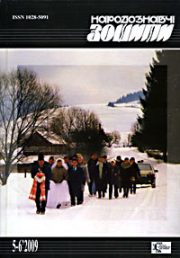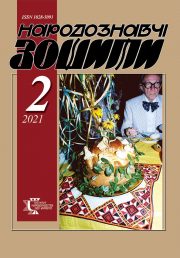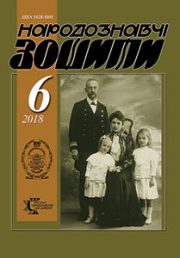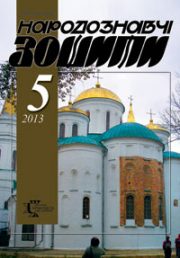The Ethnology Notebooks. 2025. № 3 (183), 521—528
UDK 792.83:793.3(=161.2):008]355.01
DOI https://doi.org/10.15407/nz2025.03.521
CHOREOGRAPHIC RITUALS IN THE AUTHOR‘S MODELS OF OSIP SOROKHTEI
BABII Nadiia
- ORCID ID: https://orcid.org/0000-0002-9572-791X
- DSc in Art Studies, Professor,
- Vasyl Stefanyc Precarpathian National University,
- 57, Shevchenko St., 76000, Ivano-Frankivsk, Ukraine,
- Contacts: e-mail: nadiia.babii@pnu.edu.ua
YAKYMECHKO Mykola
- ORCID ID: https://orcid.org/0009-0003-3244-9451
- Assistant Professor,
- Vasyl Stefanyc Precarpathian National University,
- 57, Shevchenko St., 76000, Ivano-Frankivsk, Ukraine,
- Contacts: e-mail: mykola.yakymechko@pnu.edu.ua
Abstract. The relevance of the study is determined by the analysis of the drawing «Arkan» by Osyp Sorohtey in a common discursive field with choreographic rituals and works of Ukrainian and world modernists.The object of the study is the artistic discourse around the image of dance. The subject is the interpretation of the dance topos in the small graphics of Osyp Sorokhtei. The greatest attention is paid to the drawing «Arkan» (1916), created by the artist during his time in the ranks of the Ukrainian Sich Riflemen, working in the military editorial office of the Press Quartet «Streletska Kadra». This work is considered in the context of modern culture and in the interconnection of the author’s personal experience of war and the experiences of other artists who at different times expressed their observations of social transformations and attitudes towards war and death through the thematisation of dance. Research methods. Historical, cultural and art historical methods are used to consider the specifics of dance interpretation in the aesthetic coordinates of art. A comparative analysis based on interdisciplinary studies, the search for common universals in literature, choreography, drama, painting, graphics, and cinema is also included.
Result. The research has revealed that interest in choreographic reminiscences is growing in times of social upheaval. Pyrrhic dance, macabre dance, and domestic dance through works of art acquire the functions of communicators with the world. They are important choreographic images through which the themes of life and death are comprehended. It is proved that Osyp Sorokhtei’s drawing «The Arcana» (1916) should be considered as an expressive image of war in the context of the modernist appeal to rituals. In a large array of visual and literary works, it stands out for its tragic expressionist worldview and special rhythmicity, reproduced by means of drawing through the tempo of dancing boots and the long mute cry or moan of the characters. This is the first study in the national scientific discourse devoted to the analysis of the topos of dance in the interpretations of Osyp Sorokhtei.
Keywords: Osyp Sorokhtei, topos of dance in art, dance of death, modern culture, war.
Received 8.05.2025
REFERENCES
- Rozhak-Lytvynenko, K. (2017). The artistic grouping of the Ukrainian Sich Riflemen: the artists, traditions, genre and style features of the works. Dissertation for Candidate of Arts degree (PhD). Lviv National Academy of Arts [in Ukrainian].
- Lukan, V. (2018). Usususy Osypa Sorokhteia. Kraieznavets Prykarpattia, 32, 52—54 [in Ukrainian].
- Mackenbach, JP., & Dreier, RP. (2012). Dances of Death: macabre mirrors of an unequal society. Int J Public Health, 57 (6), 915—24. DOI: 10.1007/s00038-012-0381-x
- Halchuk, О. (2021). The reminiscences of Salome’s dance and the dance macabre in authors’ models of the late 19th — early 20th centuries literature. Synopsis: text, context, media. 27 (3), 128—135. Retrieved from: https://doi.org/10.28925/2311-259x.2021.3.12021 [in Ukrainian].
- Zubrytska, M. (1996). Ontologization of death in the works of Vasyl Stefanyk. Studies of integral culture. Thanatos, 1, 21—24 [in Ukrainian].
- Henri, Matisse. The Dance. The Museum of Modern Art, MoMA Highlights (P. 69). New York: The Museum of Modern Art, revised 2004, originally published 1999.
- Silver, L. (2011). Pieter Bruegel. New York; London.
- La Carmagnole (The Dance Around the Guillotine). Retrieved from: http://portlandartmuseum.us/mwebcgi/mweb.exe?request=record;id=24697;type=101
- Nechytalyuk, І. (2021). Corporeality in Oleksandr Dovzhenko’s Project La Terra: Performativity Aspects. Pogranicza w literaturze i kulturze. Kontekst wschodnioeuropejsk. Bibliotekarz podlaski, 2, 123—136 [in Ukrainian].
- Turianskyi, O. (1989). Beyond Limits of Pain. Kyiv [in Ukrainian].
- Haivoronsky, M. (1916). Riflemen’s Songs and Trumpets.Zbruc. Retrieved from: https://zbruc.eu/node/49038 [in Ukrainian].
- Fedortsiv, F. (1915). From the publisher. Shliakhy. Lviv [in Ukrainian].
- Shandura, O. (1915). Salome. On the Margins of Wilde’s Drama (Instead of a Theatre Review)]. Shliakhy (Part І, pp.11—14). Lviv [in Ukrainian].
- Ripko, O. (2008). Osyp Sorohtey’s Stations of the Cross. In: Osyp Sorokhtei (Pp. 5—22). Lviv [in Ukrainian].
- (1971). Exhibition of works by caricaturist Osip Sorohtey, dedicated to his 80th birthday. Ivano-Frankivsk [in Ukra inian].
- Figol, M. (1990). Osyp Sorokhtei. Exhibition catalog. Ivano-Frankivsk regional organization of the Ukrainian Society for the Protection of Historical and Cultural Monuments. Ivano-Frankivsk: Oblpoligrafvydav [in Ukrainian].
- Osyp-Roman Sorokhtei. Retrieved from: https://sorokhtei.org.ua [in Ukrainian].
- Relief with dancing warriors. Rome, Vatican Museums, Pius-Clementine Museum, Room of the Muses, 66 (Roma, Musei Vaticani, Museo Pio-Clementino, Sala delle muse). Retrieved from: https://ancientrome.ru/art/artworken/img.htm?id=5378
- Corvisier, A. (1998). Les danses macabres. Paris: QUE SAIS JE [in French].
- Baudelaire, Ch. (1989). Poetry. Dnipro[in Ukrainian].
- Kasprowicz, J. Salome. Retrieved from: https://poezja.org/wz/Jan_Kasprowicz/23339/Salome [in Polish].
- (1915). In the cycle of events. Shliakhy (Pp. 33—36). Lviv [in Ukrainian].







